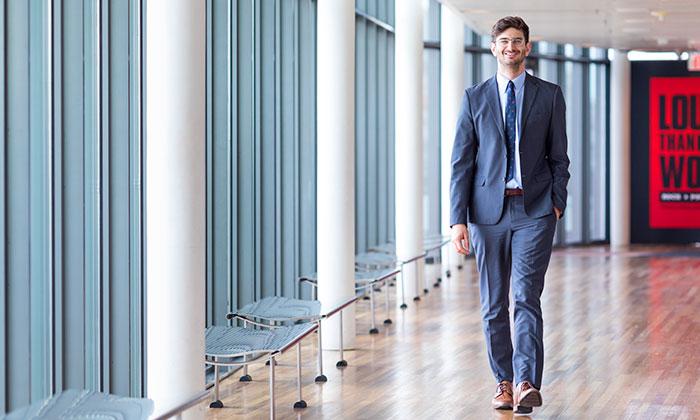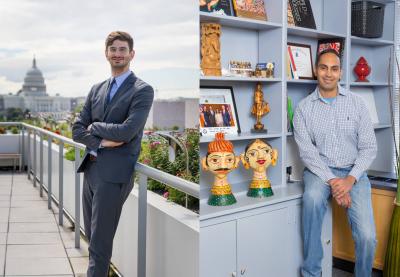Benjamin Marcus is the religious literacy specialist with the Religious Freedom Center of the Newseum Institute. Murali Balaji is the director of education and curriculum reform at the Hindu American Foundation. Both men think about, teach about and witness daily the value of teaching religious literacy—and the problems that arise when we don’t. Teaching Tolerance sat down with Benjamin and Murali to talk about how educators can broach tough topics like religious freedom and how to respond to pushback from parents and administrators.

Can each of you speak to the definition of religious freedom that you use?
Murali: I define religious freedom as freedom to worship. However, it’s also the freedom of others to not have religion imposed upon them. I think that's a delicate balance that we continue to negotiate. We've seen, for example, bills being passed in different parts of the country "banning” Sharia law, which is interesting because they're irrelevant; we have a constitution that specifically prohibits any religious group from having its own set of norms that are outside of constitutional jurisdiction.
For us, religious freedom is something that we are constantly negotiating with. Oftentimes, we look at religious freedom within the context of whether an action taken in the name of religion violates the principle of “do no harm.”
Benjamin: I just wanted to give a few examples of different ways that people have defined religious freedom, because I think it adds on to what Murali was saying about the tension between religious freedom and do no harm. That tension, in some ways, is represented in our own First Amendment. The First Amendment to the U.S. Constitution says, "Congress shall make no law respecting an establishment of religion or prohibiting the free exercise thereof." Those are the two religion clauses: the free exercise clause and the establishment clause.
What happens when someone's sincerely held religious belief prohibits them, in their own eyes, from sanctioning same-sex marriage, for example? To what extent do those beliefs get enacted in the public? Whose conception of harm? And, especially, what happens when different conceptions of harm come into contact with one another?
Here are two examples from the history of the United States of leaders talking about religious freedom: One comes from James Madison's Memorial and Remonstrance [Against Religious Assessments in which he quotes from the Virginia Declaration of Human Rights]. He writes, "Because we hold it for a fundamental and undeniable truth ‘that religion or the duty which we owe to our creator and the manner of discharging it can be directed only by reason and conviction, not by force or violence.’" The other comes from the [A Bill for Establishing] Religious Freedom, which was drafted by Thomas Jefferson in 1777. He says, "No man shall be compelled to frequent or support any religious worship, place or ministry whatsoever. Nor shall he be enforced, restrained, molested or burdened in his body or goods, nor shall otherwise suffer, on account of his religious opinions or belief."
I think you can see in these different quotes that there are different emphases. Some of them emphasize the actions, the exercise of religion from the translation from beliefs into behaviors. Some of them emphasize just the beliefs alone.

Why should educators teach about religious freedom? How is this topic relevant to students' personal and academic lives?
Benjamin: We're seeing a dramatic increase in religion-related hate crimes in the United States. There have been studies that show the connections between that spike in crimes and the 2016 presidential campaign, and the aftereffects of that campaign. Attacks against American Muslims surged last year, and there was also an overall increase in hate crimes.
The conflation of religious categories and racial categories has also led to an increase in hate crimes against Hindu Americans and Sikh Americans, in large part because people don't know the difference between Muslims and Hindus and Sikhs. Not that that makes it any better, but it shows that religious illiteracy is actually a matter of life and death, and that the protection of religious minorities and the societal emphasis on the importance of religious freedom for all Americans is really critical right now.
Murali: Educators need to emphasize that religious freedom is not "giving special rights" to one group or another, but that religious freedom is enshrined in our democracy.
I think this is why teaching about religious freedom at the K to 12 level is so critical towards restoring a common purpose and the importance of civics engagement. None of these things are happening in a vacuum. Islamophobia did not happen overnight. It actually didn't start with 9/11. I think what's really lent itself to the increase in hate is our lack of willingness to really talk about civic engagement and the importance of diversity in a pluralistic democracy.
What are some of the biggest challenges that educators face when addressing this topic?
Murali: The biggest challenge to teaching about religious freedom is the pushback teachers often get from parents and community organizations that are opposed to a more pluralistic understanding of religious freedom.
Benjamin: Very closely related to that is that teachers don't know that they can teach about religion. It's constitutional. It's been affirmed by the U.S. Supreme Court that actually learning about religion is really necessary for learning about our society and history.
Do either of you have any thoughts or recommendations on addressing parent pushback?
Murali: A supportive administration that can really go to bat for them and say, "Look, this is constitutionally protected. We're not trying to ‘convert’ your student, your child. What we are trying to get them to do is get them to understand the different faith groups that make up this country." It really does take teachers having this strong administrative support network.
Benjamin: I think one powerful piece of evidence that teachers can use is a study that was conducted [at a school] in Modesto, California that required a world religions course be taught to all students.
What that study showed was that not only did the world religions class increase students' willingness to take action when they witnessed one student insulting another based on religious beliefs, but it also did not affect their own religiosity. That might be one piece of evidence that teachers can use to show that this isn't some subterfuge or back-way exercise of trying to make all students nonreligious. Students of religion and none can flourish in a course that teaches about religion.
I would also say the discussion of what to do to allay the concerns of parents is really, like Murali said, it's community to community. Different parts of the United States are just very different, so I hesitate to give a one size fits all model. I will say that I work with some teachers in the suburbs of Chicago who have run classes now for many years teaching about religion. I think they're so successful, and they have so few parent complaints, because they engage parents directly.
One of the teachers has students complete activities that require interviews with their parents about different religious subjects. When parents feel involved and they feel like the school isn't trying to take away the religious formation of their students but is trying to teach about religion in an academic way, I think that can also allay some concerns.
Is there anything else you’d like to emphasize for Teaching Tolerance readers?
Benjamin: The historical view is really critical when talking about religious freedoms. There can be false assertions that the United States has had a standard or stable conception of religious freedom since its founding. That's just not true, but we have idealized religious freedom from the beginning. The ways that we negotiate that are very different, and I think it can shed some light on today's conversations when students understand that this isn't new, that we've negotiated concepts of religious freedoms since the beginning.
Murali: I would just add that cultural competency is paramount. Cultural competency and religious literacy are vital to understanding our changing country, and in many ways are critical to upholding our democracy. The attacks on our democracy can be prevented with a more culturally aware and religiously literate society. That's really important as we move forward. Our teachers need to have those tools at their disposal.
Two Frameworks for Teaching About Religion
Three Rs Framework
The Three Rs Framework is based on the Williamsburg Charter and further developed by Charles Haynes of the Newseum Institute’s Religious Freedom Center and Oliver Thomas, a minister, attorney and scholar. You can read more about the Three Rs Framework here.
Rights.
Religious freedom is a precious, fundamental and inalienable right for people of all religions and of no religion. This right is protected by the First Amendment.
Responsibility.
Religious freedom is a universal right joined to a universal duty to respect that right for others.
Respect.
Conflict and debate are vital to democracy. If controversies about religion and public life are to advance the best interests of the nation, then how we debate—and not only what we debate—is critical.
Three Bs Framework
The Three Bs Framework is the work of Benjamin Marcus and is based on the scholarship of Vassilis Saroglou and Jonathan Haidt. You can read more about the Three Bs Framework here.
Belief.
What are the explicit teachings of the religion?
Behavior.
What does acting on those beliefs look like in private? In public? Within the religious community?
Belonging.
Does belonging to a particular religious community influence belonging to other groups? How does it influence identity?

